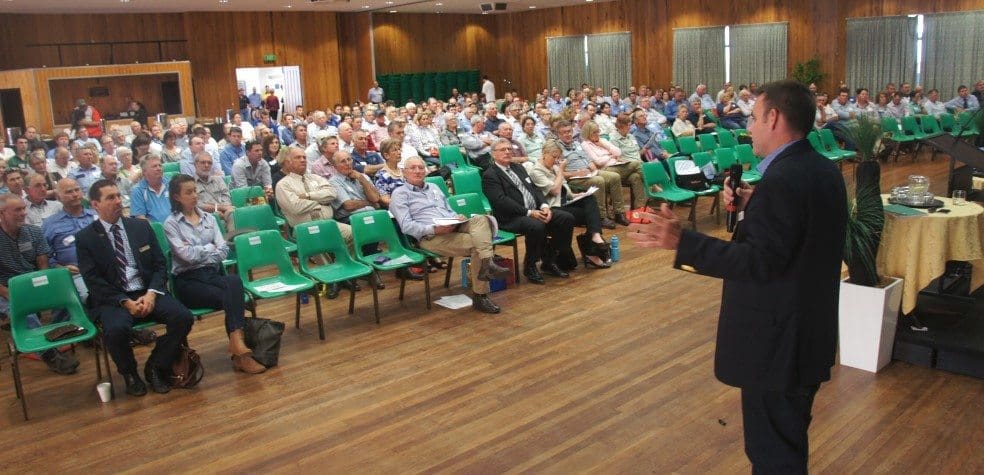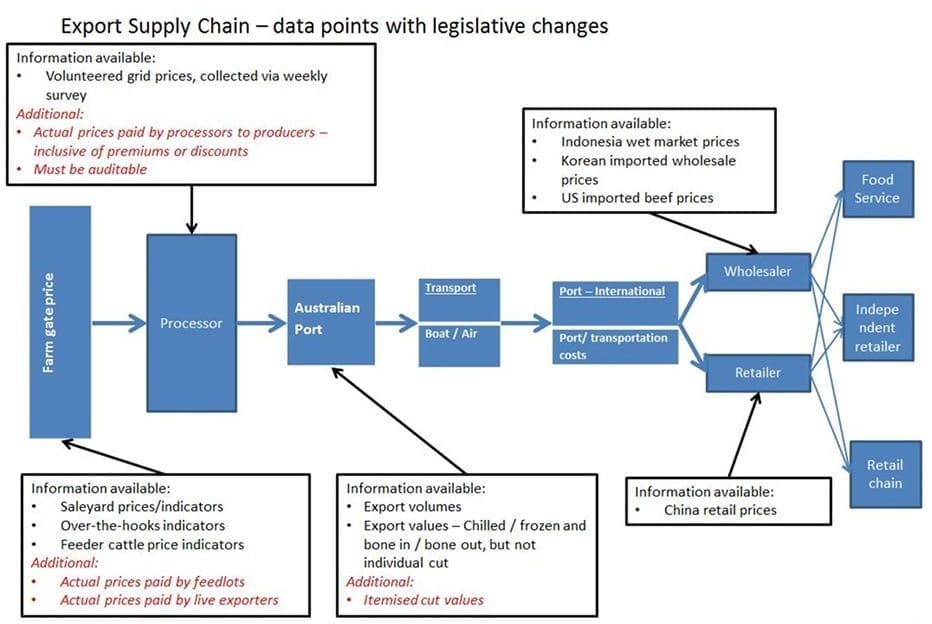
MLA managing director Richard Norton addresses the 300-strong producer forum in Biloela, Central Queensland yesterday. Click image for a larger view.
MEAT & Livestock Australia’s managing director Richard Norton has suggested that the red meat industry has some big decisions coming up over what it wants to do – if anything – over implementation of some form of supply-chain-wide price transparency mechanism.
Mr Norton yesterday gave a brief update on the research process so far, tasked earlier this year to MLA, during a producer forum in Biloela, Central Queensland.
The price transparency project – recommendation number seven put forward by the recent Senate Inquiry into grassfed levies – had now reached the fifth of seven project milestones, Mr Norton said.
“The earlier milestones in the project probably came up with more questions than answers,” he told yesterday’s Biloela beef form in Central Queensland.
“Where we are now up to is for the industry to decide what it wants to do next,” he said.
Mr Norton highlighted some clear and important distinctions between the circumstances in Australia, and those in the US, where the version of mandatory price reporting that everybody refers to was built around a heavily domestic-focused market.
“Within the report, various people from the US Department of Agriculture were interviewed. Some said they did not believe mandatory price reporting had increased farmgate prices to US cattle producers.
“There were certain parts of the US supply chain that were not covered by mandatory price reporting. Because of that, some stakeholders said, they didn’t believe the price signal data that was being generated. But when the US made those segments mandatory, it was found that the original price signal data was correct – so little was achieved,” Mr Norton said.
He said Australia was unlikely ever to achieve full through-chain price transparency, because of the complex nature of an export-focussed industry.
“We’re not going to go in and ask a processor for their cost of production, so that we can get full price transparency. What we might get is more market indicators,” he said.
“What the industry now needs to decide is what it wants to do next. Does it want to spend another million dollars or two investigating price transparency? Is it going to add value at farmgate? On the counter-side, is there a risk it would tell our global meat customers exactly what our price is, ex-processing plant – to our disadvantage in meat price negotiation?”
“The issue for Australia in any transparency model is that unlike the US, we are not a heavily domestic focused market. Seventy six percent of our beef is exported.”
“Australia is far more dependent on global protein market dynamics than our competitors in Brazil and the US,” Mr Norton said.
Referring to flow chart of a typical Australian export value-chain (published below), Mr Norton said the project’s recommendations were that if pricing signals were to be achieved that had an impact at farmgate, it would be necessary to source ‘actual prices paid’ by processors – not simply asking processors what their grid offers currently were.
“We’d need to be able to ask, Wwhat did you pay on Tueday this week, including discounts and premiums,” Mr Norton said. “And we’d need to source the same information from the lotfeeding industry and the live export industry.”
A lot of additional assumptions like transport, would have to be worked out n going through to global markets.
“At the moment in Queensland, for example, we are already taking 98 different price signal measurements each month in the beef chain,” Mr Norton said.
“There’s lots of market reporting out there already – it’s the uptake and the use of that market reporting that needs to be done. And is any proposed transparency reporting simply going to overlay more market reporting and price signals? And are they likely to be abused?” he asked.
Mr Norton said that none of this was an MLA decision – its purpose was simply to provide the data and the facts – but such decisions would have to be made by industry itself.
While the domestic market supply chain was ‘relatively simple’ compared with export, unless the industry was prepared to spend a ‘lot of money’ on getting information like retail scanning data, it would never hope to deliver full price transparency, he said.
“The question to industry is – and I’m only making assumptions – let’s say in 2014 the producer was getting 30pc of retail price, and the processor, 50pc. Today the tide has turned, and the producer may be getting 50-60pc, and the processor 20-30pc, for argument’s sake.
“What and where do you want government to intervene in that process?” Mr Norton said.
“We can give price signals all along the chain, but the question is, does the industry want intervention along that value-chain?”
Mr Norton told Beef Central after his presentation that the work done so far clearly demonstrated that there was no equivalent model overseas from which the Australian industry could work. The US was around 85pc dependent in its domestic market – the exact opposite to Australia.
“We can ask industry to give us enormous amounts of price signal data, to better inform stakeholders about what is actually happening in the grid price over-the-hooks trading system including discounts and premiums paid. But that is only a price signal – not price transparency,” he said.
Other areas would have to be sacrificed
Mr Norton suggested that to meet the budgetary constraints that would apply, if a price transparency model was adopted, it could mean sacrifices, or even withdrawal from traditional market reporting in areas like saleyards reporting or the EYCI.
“Hypothetically, it could mean, for example, that the 45 livestock markets currently reported across Australia each week might have to come back to 20,” he said.
“That might save a million dollars a year, that could be put into an over the hooks trading system, if that’s what the industry wants to do,” he said. “But one of the priorities that always rates very highly when we do producer surveys is in what we are currently doing, in market reporting.”
“If cuts aren’t made there, we’d have to work with peak councils to decide whether we’d sacrifice something else to pay for enhanced over the hooks trading price information.”
However he stressed that the consideration was not yet up to the cost/benefit analysis stage.
Any cost burden would become particularly acute, Mr Norton said, as national slaughter declines over the next two or three years, with a consequent decline in levy funds.
“Would the industry get a million dollars worth of value from such a move? That’s a decision for industry. MLA will obviously facilitate that decision-making process, but it’s quite obvious that over-the hooks trading is becoming THE market signal.
“And as seasons improve and there is higher demand for fewer cattle, a lot more will go direct to works,” he said.
“The bottom line is, we are enhancing our over-the-hooks market reporting systems to give better market signals. But the industry could spend tens of millions of dollars and it will never achieve market transparency, because that would require legislation.”
“The report is now focussing on what areas we could deliver on, and whether it represents the best bang for our buck,” Mr Norton said.
“I don’t know that there would be much appetite among our regulators to legislate in the supply chain about price signals coming back.”
Read AFI head, Mick Keogh’s recent opinion article: Does price transparency fix sick markets?




Loretta – in case you hadn’t noticed, it has not rained, so there are more livestock on the market. You have an EYCI as the saleyard guide on price – do you want a single desk for beef or a fixed price for all farmers? Please start living in the real world and stop bashing processors.
Another one or two million dollars spent to improve price transparency is insignificant when you consider over the last 2 weeks beef farmers collectively have lost well into the millions due to the sudden fall in saleyard prices. Please Mr Norton do not pre-empt the outcomes of the price transparency project. I believe their may be huge support in our industry for mandatory price transparency as was highlighted in the Senate inquiry into Industry Levies & Structures. We need major change in the industry no matter how difficult – lets be innovative – enjoy the difficult – to save our farmers!
A lot of recent industry talk has revolved around ‘value based marketing’ (VBM), if we are to have a supply chain focused on maximizing returns across the value chain, wouldn’t a credible way of reporting what product has the potential to maximize returns be crucial? MLA General Manager Red Meat Innovation Alex Ball, also addressed yesterday’s gathering. During his presentation he mentioned that non-compliance was costing industry up to $56 a head, whilst a 5% productivity gain would add $12 a head. Obviously there is potential for greater profitability in our industry if all sectors were to start to focus on efficiency gains and maximizing returns, rather than a ‘high thru put with minimal margin’ business model. We continually hear that we are a high cost of production industry, the processing sector claims that we can remain competitive globally because our low cost production sector offsets the high costs associated with other sectors, this needs to be addressed. Low cost production is most likely to succeed in a commodity focused industry, there is much evidence that suggests we will be unlikely to remain profitable in that space, thus the talk of VBM using eating quality and yield as a way to determine price received is to be commended. There is the possibility of prosperous times ahead, this will take a value chain approach rather than sectors, we will need a credible way of communicating what is the best way to attain the highest value!